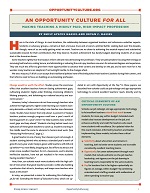 Making Teaching a Highly Paid, High-Impact Profession
Making Teaching a Highly Paid, High-Impact Profession
Full Report [pdf] | Summary [pdf]
In this brief written in 2013, Public Impact® Co-Presidents Emily Ayscue Hassel and Bryan C. Hassel shared their vision of an Opportunity Culture®, explaining how extending the reach of great teachers can start a virtuous cycle of excellence and higher pay for all teachers.
Coming soon: A refreshed vision, based on lessons from and research on the national Opportunity Culture® initiative!
